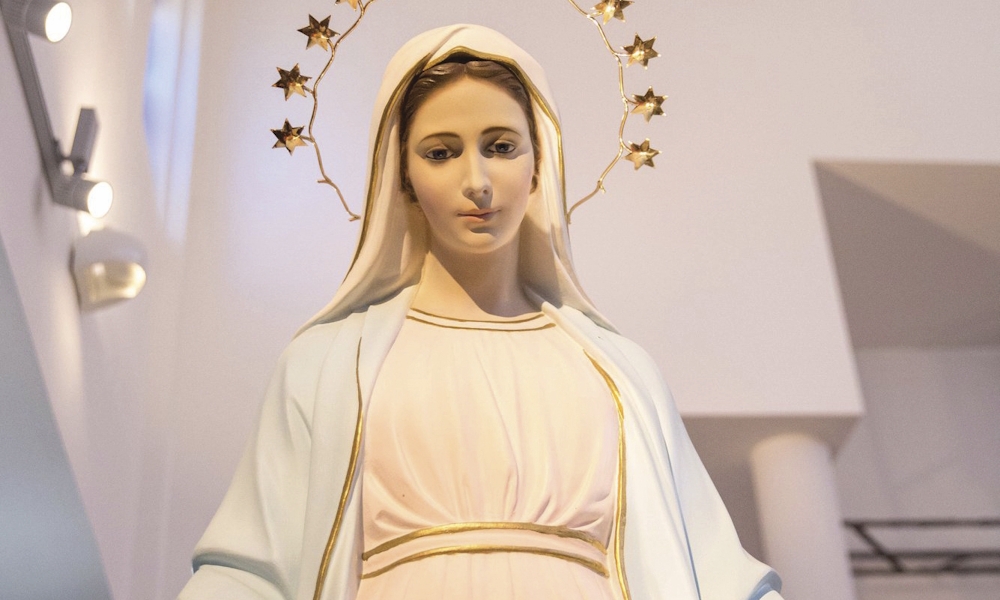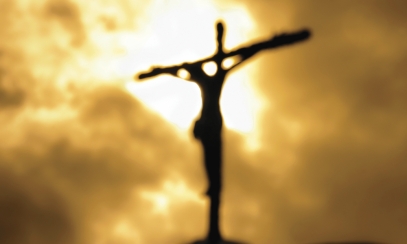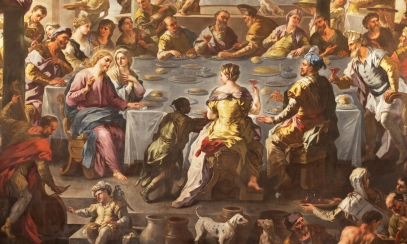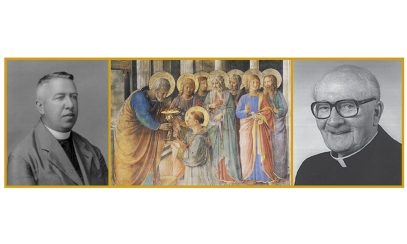
The Case of the Marian Mystery
How a National Research Project Originating in Saginaw Reveals the Impact of Mary, Mother of the Church
How a National Research Project Originating in Saginaw Reveals the Impact of Mary, Mother of the Church
Note: An expanded version of this article entitled “12 takeaways from new survey on Mary’s impact on vocations” appeared in Our Sunday Visitor on July 18, 2025.
In 1989, Mary played a key role in my “reversion,” when she gently nudged me to return to the practice of the Catholic Faith when I was drifting away. Thirty-four years later, I again experienced a nudge in prayer. This time, it was to pull back the curtain on what theologians call “the Marian mystery” – that is, Mary’s hidden but powerful impact on the Church.
Note: An expanded version of this article entitled “12 takeaways from new survey on Mary’s impact on vocations” appeared in Our Sunday Visitor on July 18, 2025.
In 1989, Mary played a key role in my “reversion,” when she gently nudged me to return to the practice of the Catholic Faith when I was drifting away. Thirty-four years later, I again experienced a nudge in prayer. This time, it was to pull back the curtain on what theologians call “the Marian mystery” – that is, Mary’s hidden but powerful impact on the Church.
With the blessing of Bishop Robert Gruss, a national research study on Mary and her unique vocation as Mother of the Church was requested. The recent study was carried out by the Center for Applied Research in the Apostolate (CARA) at Georgetown University. No diocesan funds were used for this research, which was made possible by donations from some U.S. bishops and other benefactors.
It is beautiful that this study on the Marian dimension of the Church originated in our Diocese, whose chief patroness is Mary of the Assumption. I am indebted to the many benefactors, consultants and prayer warriors who helped make this labor of love for Our Lady a reality – especially Bishop Gruss and my former professor, Bishop Robert Barron, who both kindly reviewed the survey questions before they were shared with clergy and major superiors in the United States.
The Marian dimension of the Church
In coming years, some Roman pilgrims will undoubtedly search for Pope Francis’ tomb at St. Peter’s Basilica only to learn that his mortal remains are actually located at the Papal Basilica of St. Mary Major. The relic of the manger where Mary placed her newborn son is housed there, as is a work of art before which Pope Francis prayed 126 times over the 12 years of his papacy: the icon of Mary, Salus Populi Romani (protectress of the Roman people). His directive on his final resting place was the concluding note of a Marian leitmotif that ran throughout Pope Francis’ pontificate. Building on the theological legacy of Hans Urs von Balthasar, Pope Francis embraced the Swiss theologian’s view that the Marian/feminine/contemplative dimension of the Church is primary compared to the Petrine/masculine dimension, which focuses more on structures and governance. The last pope to be buried at Rome’s chief Marian basilica was Pope Clement IX in 1669. As the 265th successor of St. Peter, therefore, Pope Francis’ unusual decision to choose St. Mary Major for his entombment speaks eloquently about his conviction that Mary’s spirit of prayerful, contemplative receptivity is more fundamental to the life of the Church than St. Peter’s role of active governance. Ecclesia, after all, is a feminine word.
Results of the 2025 national Marian survey
On July 16, CARA released its report on the first-of-its-kind survey entitled, “Impact of Mary, Mother of the Church, on Ecclesial Vocations.” Published on the day the Church honors Our Lady of Mount Carmel, the report provides the findings of a Marian survey of bishops, priests, deacons, deacon directors and major superiors in the United States. The study took place during the first half of 2025, with 1,091 survey responses. The director of CARA, Father Tom Gaunt, S.J., shared that this is likely the first time a Marian study has had social science supporting it.
As mentioned, the idea for this project came to me in prayer after Pope Francis made a heartfelt plea on Nov. 30, 2023, asking theologians to explore with fresh vigor the Marian/feminine dimension of the Church. This happened to be the focus of my thesis work at the Angelicum in Rome. Along with answering Pope Francis’ call, I also consider this project to be a way to honor and thank the Blessed Mother for her role in leading me to my own ecclesial vocation. Without Mary’s intervention in my life when I was 26, I would not be serving her Son and the Church today.
The aim of this research was to better understand Mary’s impact on the Church, specifically regarding those who have embraced priestly, diaconal and religious vocations. The study provides Church leaders, seminaries, vocation directors, deacon directors, religious institutes and laity with concrete data on the significance of “the Marian principle” in the Church – particularly at a time when fostering ecclesial vocations is a priority in most dioceses and religious institutes in the western world.
Top 9 takeaways from the results of the Marian research study
- Mary's role as "Mother of the Church" is borne out by the fact that a combined 89% of respondents report having a strong devotion (58%) or some devotion (31%) to Mary. Furthermore, 74% report that their devotion to Mary has “strengthened” (34%) or “very much strengthened” them (41%) in living out their ecclesial vocations.
- The home, often called the “domestic church,” is by far the most powerful setting to cultivate Marian devotion. When asked where their devotion to Mary was fostered, 79% of respondents state that it was in their home, 44% say their parish and 44% indicate a Catholic school. This means that parents, guardians and grandparents have a critical role in instilling a love for Mary, along with her prayerful receptive spirit, in children.
- Given how the Catholic Church in the United States has recently prioritized a Eucharistic revival, it is noteworthy that 80% of respondents indicate that Marian devotion has strengthened their Eucharistic devotion – a finding that reinforces the traditional Catholic mantra, "to Jesus through Mary."
- Mary clearly has a key role in fostering vocations to the priesthood, diaconate and religious life, with 71% of respondents reporting that they prayed the Rosary privately while discerning an ecclesial vocation.
- The impact of Marian apparitions is noteworthy. Clergy and major superiors report that the following approved apparitions had a great or meaningful impact on their original sense of an ecclesial vocation: Fatima (44%), Lourdes (43%), and Guadalupe (31%). And though the reported apparitions of Mary at Medjugorje only date back to 1981, the impact of "the spiritual experience of Medjugorje" on ecclesial vocations is also evident. Of the respondents, 14% report that Medjugorje had a great or meaningful impact on their original sense of an ecclesial vocation. This finding recalled the words of Christoph Cardinal Schönborn, the principal drafter and editor of the Catechism of the Catholic Church. In a 2010 Gebetsktion Wien interview, he said: “If there was something wrong about Medjugorje, we would have to dismiss half of our seminarians, since so many of our priestly vocations are both directly and indirectly related to Medjugorje.”
- Pope St. John Paul II's promotion of the Marian consecration according to St. Louis de Montfort appears to have had a significant impact, with 44% of all respondents reporting that they have made this kind of Marian consecration.
- Just as Mary’s presence in the Upper Room during the nine days before Pentecost was of great importance to the first bishops of the Church (the apostles), so today the bishops of the United States rely greatly on Mary’s maternal presence in their lives. Of those bishops surveyed, 96% report that they have either a strong devotion or some devotion to Mary.
- Mary has a major role in fostering either conversions to the Catholic Church or “reversions” – that is, individuals who grow up Catholic, fall away and then return to the Church. Among those reporting a conversion or reversion to Catholicism, 71% report that devotion to Mary had an impact on their decision to join or return to the Catholic Church.
- The Rosary continues to hold a place of great importance in the devotional life of Catholic leadership in the United States, with 87% of bishops reporting that they pray the Rosary privately, followed by 77% of diocesan priests.
Mary, the Church and “holy soil”
Hopefully, the results of this Marian research project will be fruitfully received – not just by clergy, religious and laity in the U.S, but by the universal Church. “Fruitful receptivity” and “the Marian principle” are, in fact, closely interwoven, as the future Pope Benedict XVI observes in the book he co-authored with his friend, Hans Urs von Balthasar, Mary: The Church at the Source. As opposed to “the masculine principle” in the Church which often amounts to endless planning and frenetic activity, the former Cardinal Ratzinger makes a prophetic plea for the Church to prioritize “the Marian principle” and follow the Blessed Virgin Mother’s example of being receptive “holy soil”:
“The Church is not a manufactured item; she is, rather, the living seed of God that must be allowed to grow and ripen. This is why the Church needs the Marian mystery; this is why the Church herself is a Marian mystery. There can be fruitfulness in the Church only when she has this character, when she becomes holy soil for the Word. We must retrieve the symbol of the fruitful soil; we must once more become waiting, inwardly recollected people who, in the depth of prayer, longing and faith, give the Word room to grow.”
Dr. Dan Osborn is the Diocesan Theologian and Coordinator of Permanent Diaconate Formation & Ministry for the Diocese of Saginaw.



